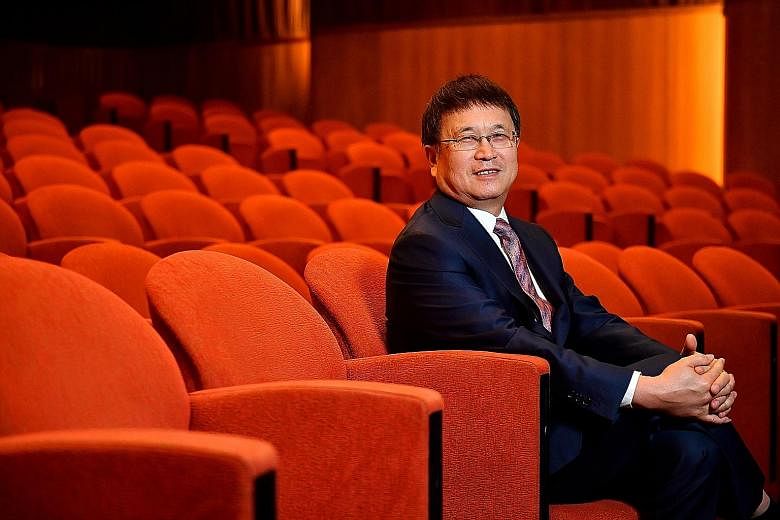Shipbuilders may be on the cusp of a tentative recovery after weathering a nadir last year that some industry leaders have described as one of the longest and deepest, going by recent results unveiled by the big players.
Singapore-listed Yangzijiang Shipbuilding (Holdings) saw its earnings jump by 49 per cent in the first quarter, while the world's two largest shipbuilders - South Korea-based Hyundai and Daewoo - have recorded sizeable gains in profit amid an improved outlook.
"Last year was the worst," Yangzijiang executive chairman Ren Yuanlin told The Straits Times in an interview last week, pointing to an industry racked by a capacity glut and lacklustre demand. "But we are expecting this year to be better."
Mr Ren noted that market sentiment has picked up since the start of the year.
"New vessels are priced at very attractive levels now, which has helped to support demand. And because of the increasingly stringent global maritime regulations, owners have to renew or upgrade their older fleets."
China-based Yangzijiang booked a net profit of 667.7 million yuan (S$135.3 million) for the three months ended March 31, up 49 per cent from the same period a year earlier.
This was on the back of higher revenues in its shipbuilding business, helped by lower prices for steel and depreciation in the yuan, said Mr Ren in Mandarin.
The group, which celebrated its 10th year of listing on the Singapore Exchange last Friday, secured 13 new shipbuilding orders worth US$318 million (S$444 million). At the same time, it managed to sell four bulk carriers for a total of 551 million yuan - an indication that demand is on the mend, he noted. Orders for these vessels were terminated by the original buyer last year.
Mr Ren added that Yangzijiang aims to secure twice as much in value of new job orders this year, from 823 million yuan in 2016.
The group's order book stood at US$4.03 billion as of March 31, comprising 84 vessels, putting it at No. 1 among all shipyards in China, and No. 4 in the world, according to reports from Eworldship.com and Clarksons.
"There are still a few bright spots in the market, such as for very large ore carriers as well as clean-energy vessels like small-scale liquefied natural gas (LNG) carriers," he said.
Yangzijiang delivered its first two LNG carriers during the quarter as it looks to expand its presence in building these specialised vessels.
Meanwhile, in South Korea, Daewoo Shipbuilding & Marine Engineering is set to deliver more than 30 LNG carriers through next year, which will help improve its earnings. The firm was bailed out twice by creditors in the last two years. It narrowly averted a payment crisis last month after bond holders agreed to a debt revamp.
Hyundai Heavy Industries, the world's largest shipyard, swung back into the black in the first quarter. It said it received US$1.42 billion worth of orders in the first four months of the year, and expects more in the coming months.
"We are getting double the number of inquiries for orders this year," said Hyundai Heavy in a Bloomberg report.
Mr Peter Sand, chief shipping analyst at international shipping association Bimco, said in a recent report that the overall supply-demand balance in container shipping, for example, is improving.
He still expects the global fleet to grow by 2.9 per cent this year, under the assumptions that 450,000 twenty-foot equivalent units (TEUs) of capacity will be demolished and one million TEUs will be delivered.
As for the dry bulk shipping market, the "stronger-than-expected demand" seen in recent months could see owners return to the shipyards, said Mr Sand.
"So far, we have not seen a flood of new orders, but the shipyard industry certainly stands ready to take owners' new orders," he noted.
Indeed, Yangzijiang's Mr Ren believes that the shipbuilding industry is not yet completely out of the woods.
"For the next two to three years, it will still be hard to see a huge recovery in the industry. The cancellations will continue to happen," he said. "Demand in the global economy has improved, but it hasn't been revived in a big way. The oversupply situation is also unlikely to go away any time soon."
Governments have continued to prop up the Korean and Chinese state-owned shipyards financially, which has only exacerbated the problem, he noted.
"Overall, the pie has shrunk by a lot, as much as 60 per cent," said Mr Ren. He added that Yangzijiang saw 14 order terminations last year, as its customers sought to cut costs, although it has managed to resell the vessels - mostly bulk carriers - in the market.
Like other yards, the group has embarked on aggressive cost-cutting measures. It has mothballed two smaller yards of its four yards in China, and slashed 30 per cent of its headcount to around 20,000, from a peak of 28,000 employees in 2014.
"But judging from our order book now, we hope not to cut any more jobs this year," he said.


